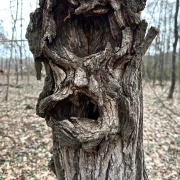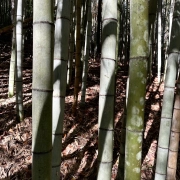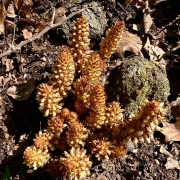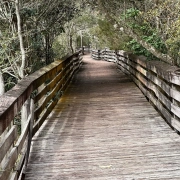Education and Interpretation: Adding Value to Experiencing Alabama’s State Parks
A lifetime Nature enthusiast, I retired and we relocated to Madison, Alabama in 2018 to be near our daughter and her two sons. We viewed this relocation as the final of 13 interstate moves across our careers. As I adjusted to retirement, a small group of committed volunteers invited me to join their fledgling efforts to create the Alabama State Parks Foundation. I am a founding member of the ASPF Board. Since our first quarterly meeting, I have championed the cause of increasing the Park System’s capacity to perform the third of its three major functions: First, to acquire and preserve natural areas; second, to develop, furnish, operate, and maintain recreational facilities; and third, to extend the public’s knowledge of the state’s natural environment.
At the outset of my involvement, the System had staff naturalists at only Guntersville, DeSoto, Cheaha, and Gulf State Parks. The System now has dedicated naturalists at eleven parks, some of which have one or more assistant naturalists.
Early Introduction to Alabama State Park Naturalists
I am grateful for the gracious introductions to Guntersville, DeSoto, Gulf, and Cheaha State Parks that Naturalists Mike Ezell (retired), Britney Hughes, Kelly Reetz, and Mandy Pearson (elsewhere employed), respectively, shared with me. Consummate, dedicated, and passionate educators and interpreters one and all. I learned so very much…and continue to learn each time I interact with Alabama’s best and brightest!
Mike Ezell on an early morning above fog-draped Guntersville Lake. Britney Hughes leading us on a rain-enhanced tour of DeSoto rock formations.
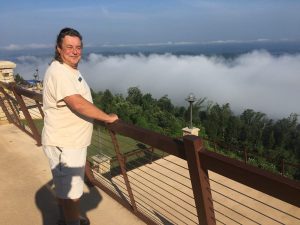

Kelly Reetz standing at the gateway to the Gulf State Park Pier. Mandy Pearson welcoming me to the Cheaha Interpretive Center at Cheaha Lake.
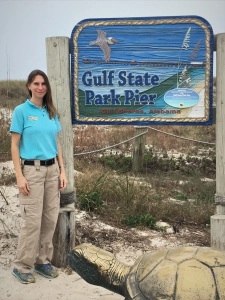
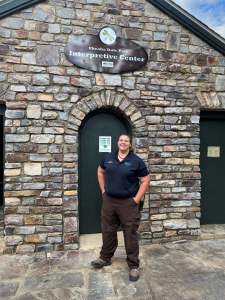
My retirement Mission (Employ writing and speaking to educate, inspire, and enable readers and listeners to understand, appreciate, and enjoy Nature… and accept and practice Earth Stewardship.) meshes well with the Park System’s education and interpretation objectives.
On May 7, 2024 I accepted an invitation to join Naturalists Renee Raney (Park System Chief of Education and Interpretation), Amber Coger (Northwest District Naturalist), Jennings Earnest (Joe Wheeler State Park Naturalist), and contracted writer Jeff Emerson to provide Jeff with insight to the practice, philosophy, and substance of State Park education and interpretation.
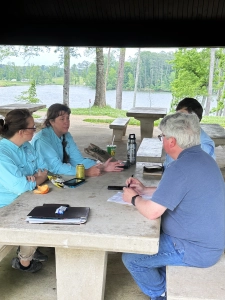
Here’s my 32-second video of the group under the Day Use Area pavilion at Joe Wheeler State Park:
[Note: Soul Grown published Jeff’s resultant article June 17, 2024: https://soul-grown.com/natures-wonder-book-alabama-state-parks-educate-and-inspire/]
Renee and I connected at Joe Wheeler SP September 19, 2023, to record a brief video promoting a University of Alabama in Huntsville OLLI (Osher Lifelong Learning Institute) course on Alabama State Parks we would be teaching during the 2023 fall term.
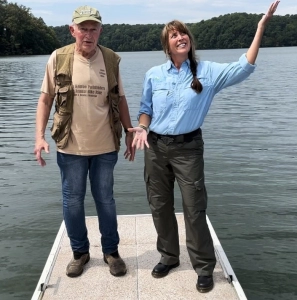
We also recorded this 60-second video introducing Renee as the first-ever State Parks Chief of Education and Interpretation.
Renee’s passion for immersing children of all ages in Nature is limitless.
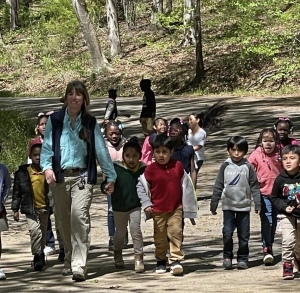
Nature education and interpretation is a contact sport!
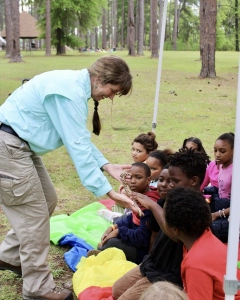
Renee leads by example; her methods are contagious!
Words of Wisdom from from Some Epic American Conservationists
I am not alone nor am I the first person addicted to Nature education, interpretation, and study. I take great comfort in knowing that conservation giants long ago clearly stated the themes, constructs, and wisdom that came to me only over a five-decade career. The quotations below are not intended to be exhaustive, but only representative.
Theodore Roosevelt encapsulated the essential and necessary intended purpose of Alabama State Park education and interpretation:
It is an incalculable added pleasure to anyone’s sum of happiness if he or she grows to know, even slightly and imperfectly, how to read and enjoy the wonder-book of nature.
Teddy’s insight could stand alone, yet there are others who helped weave the tapestry of Nature education and interpretation. Every State Park naturalist I have met is familiar with the Nature education and interpretation quilt and these significant conservationists.
Aldo Leopold, a mid-Twentieth Century forester and wildlife biologist, the author of A Sand County Almanac, wrote lyrically and philosophically:
- Education (formal), I fear, is learning to see one thing by going blind to another.
- Is education (formal) possibly a process of trading awareness for things of lesser worth?
- The last word in ignorance is the man who says of an animal or plant, “What good is it?” If the land mechanism as a whole is good, then every part is good, whether we understand it or not. If the biota, in the course of eons, has built something we like but do not understand, then who but a fool would discard seemingly useless parts? To keep every cog and wheel is the first precaution of intelligent tinkering.
John Muir quotes from 150 years ago:
- I am learning nothing in this trivial world of men. I must break away and get out into the mountains to learn the news.
- The power of imagination makes us infinite.
Einstein, to the dismay of many who know him only for his genius in physics and the philosophy of science, contributed to beautiful weaving that tells the story, wonder, magic, awe, and inspiration of Nature:
- Look deep into nature, and then you will understand everything better.
- All religions, arts, and sciences are branches of the same tree.
- He who can no longer pause to wonder and stand rapt in awe, is as good as dead; his eyes are closed.
- Imagination is more important than knowledge. Knowledge is limited. Imagination encircles the world.
- The most beautiful experience we can have is the mysterious.
- The important thing is not to stop questioning. Curiosity has its own reason for existence.
Sauntering as a Technique for Experiencing and Learning from Nature
John Muir stands tall as an American conservationist and contemporary of Teddy Roosevelt. He echoed the sentiment I have expressed frequently in these Great Blue Heron photo essays: I hike the forest immersed in its essence, rather than rush through the forest intent upon reaching a destination.
- Hiking…I don’t like either the word or the thing. People ought to saunter in the mountains – not hike! Do you know the origin of that word ‘saunter?’ It’s a beautiful word. Away back in the Middle Ages people used to go on pilgrimages to the Holy Land, and when people in the villages through which they passed asked where they were going, they would reply, “A la sainte terre,’ ‘To the Holy Land.’ And so they became known as sainte-terre-ers or saunterers. Now these mountains are our Holy Land, and we ought to saunter through them reverently, not ‘hike’ through them.
Henry David Thoreau (1817 – 1862), an American naturalist, essayist, poet, and philosopher, likewise embraced sauntering.
- It is a great art to saunter!
- In his essay “Walking,” Thoreau emphasized the importance of sauntering and connecting with nature. For him, walking was a way to discover oneself, break free from societal constraints, and experience the world more authentically.
Ralph Waldo Emerson
- A contemporary of Thoreau, Emerson had a fascinating perspective on sauntering. In his essay “Literary Ethics,” he discussed the concept of sauntering, which he also refers to as “sauntering of the afternoon.”
Jack Phillips, a naturalist, nature writer, and practicing arboricultural consultant, wrote in A Pocket Guide to Sauntering:
- On May 1st, 1857, Ralph Waldo Emerson and Henry David Thoreau went for a walk in the woods. Each of them mentioned that walk in their journals but described completely different experiences. Thoreau wrote about his cleverness in fashioning a specimen box from birch bark and didn’t have much to say about his companion. Emerson, on the other hand, praised Thoreau for his cleverness in his journal entry and hoped that their walk together would heal a rift in their friendship. He envisioned a new collaboration: “We will make a book on walking, ’tis certain, & have easy lessons for beginners. Walking in Ten Lessons.” Ralph and Henry never wrote such a book. So the task fell to me. A Pocket Guide to Sauntering draws on the journals and essays of Emerson and Thoreau. Sauntering as a way of walking originates with Thoreau; New Tree School has clarified and adapted his philosophy. The Pocket Guide states that: “A saunter, properly undertaken, explores inner landscapes as well as the terrain being traversed. It is introspective while being shaped by the lay of the land.”
New Naturalists’ Enthusiasm and Passion
I recorded brief videos to introduce Jennings Earnest and Amber Coger. Video of Jennings:
Fun is an essential element of learning!

Video of Amber:
Amber carries her passion for environmental education and interpretation on her sleeve:
The reason why I still pursue this dream (environmental education and interpretation as a career) so fervently is because I truly feel like I am making a difference with our future generations. If one student that I have taught goes on to become a scientist or an environmental educator, I will feel that my life’s work is truly worth something. We spend so much of our time trudging away at our jobs, and I feel so incredibly lucky that I get to have a career that makes an impact for the better. Environmental Educators can truly make a difference. We aren’t in this field for the money, but the rewards we get from our work daily make us so much richer than those in the most financially lucrative of careers.
Sharing knowledge with kindred souls adds value to learning!
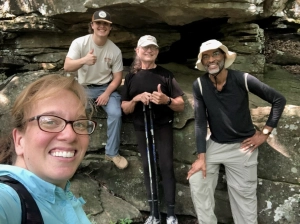
I met with then new naturalist Dylan Ogle last November at Wind Creek State Park. This brief video captures Dylan’s enthusiasm and love for the park and his new assignment:
Dylan, Jennings, Amber, and Renee remind me of the unfathomable joy I felt for each career step along my 50-year professional journey. I never held a job I didn’t love, even the tough ones and the stressful times. I never experienced a job-related misery that a trip into Nature could not dissipate.
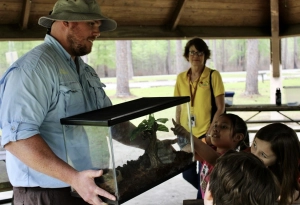
I have said often to educators across my career, “People don’t care how much you know…until they know how much you care.” I asked an accompanying graduate student her impression of a lecture I had just given on Timber Taxation during my Penn State University tenure. She responded honestly, “Dull and uninspiring.” I decided then that dull and uninspiring does little to promote learning. Renee, Amber, Jennings, and Dylan bring excitement, passion, and enthusiasm to education and interpretation!
Alabama State Parks Foundation
Thoughts and Reflections
I offer these observations:
- Nature education and interpretation are best performed at a sauntering pace.
- We sauntered if for no purpose other than to discover what we did not anticipate.
- Sauntering through the forest we discovered treasures sufficient to extend the day and multiply our delight.
- I pity those trail travelers busied with digital devices and content only to count their steps.
Inhale and absorb Nature’s elixir. May Nature Inspire, Inform, and Reward you!
Note: Unless otherwise noted, all blog post images are created & photographed by Stephen B. Jones. Please circulate images with photo credit: “©2024 Steve Jones, Great Blue Heron LLC. All Rights Reserved.”
Another Note: If you came to this post via a Facebook posting or by another route, please sign up now (no cost… no obligation) to receive my Blog Post email alerts: http://eepurl.com/cKLJdL
And Third: I am available for Nature-Inspired Speaking, Writing, and Consulting — contact me at steve.jones.0524@gmail.com
A reminder of my Personal and Professional Purpose, Passion, and Cause
If only more of us viewed our precious environment through the filters I employ. If only my mission and vision could be multiplied by untold orders of magnitude:
Mission: Employ writing and speaking to educate, inspire, and enable readers and listeners to understand, appreciate, and enjoy Nature… and accept and practice Earth Stewardship.
Vision:
- People of all ages will pay greater attention to and engage more regularly with Nature… and will accept and practice informed and responsible Earth Stewardship.
- They will see their relationship to our natural world with new eyes… and understand their Earth home more clearly.
Tagline/Motto: Steve (Great Blue Heron) encourages and seeks a better tomorrow through Nature-Inspired Living!
Steve’s Three Books
I wrote my books Nature Based Leadership (2016), Nature-Inspired Learning and Leading (2017), and Weaned Seals and Snowy Summits: Stories of Passion for Place and Everyday Nature (2019; co-authored with Dr. Jennifer Wilhoit) to encourage all citizens to recognize and appreciate that every lesson for living, learning, serving, and leading is either written indelibly in or is powerfully inspired by Nature.
I began writing books and Posts for several reasons:
- I love hiking and exploring Nature
- I see images I want to (and do) capture with my trusty iPhone camera
- I enjoy explaining those images — an educator at heart
- I don’t play golf!
- I do love writing — it’s the hobby I never needed when my career consumed me
- Judy suggested my writing is in large measure my legacy to our two kids, our five grandkids, and all the unborn generations beyond
- And finally, perhaps my books and Blogs could reach beyond family and touch a few other lives… sow some seeds for the future
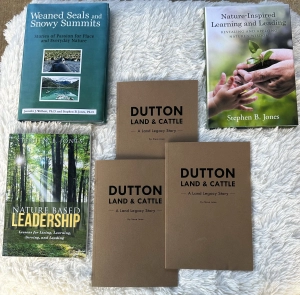
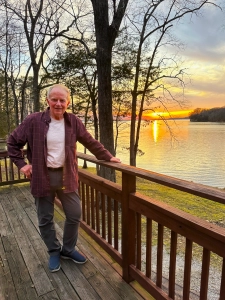
All three of my books (Nature Based Leadership; Nature-Inspired Learning and Leading; Weaned Seals and Snowy Summits) present compilations of personal experiences expressing my (and co-author Dr. Wilhoit for Weaned Seals and Snowy Summits) deep passion for Nature. All three books offer observations and reflections on my relationship with the natural world… and the broader implications for society. Order any from your local indie bookstore, or find them on IndieBound or other online sources such as Amazon and LifeRich.
I now have a fourth book, published by Dutton Land and Cattle Company, Dutton Land & Cattle: A Land Legacy Story. Available for purchase directly from me. Watch for details in a future Post.


